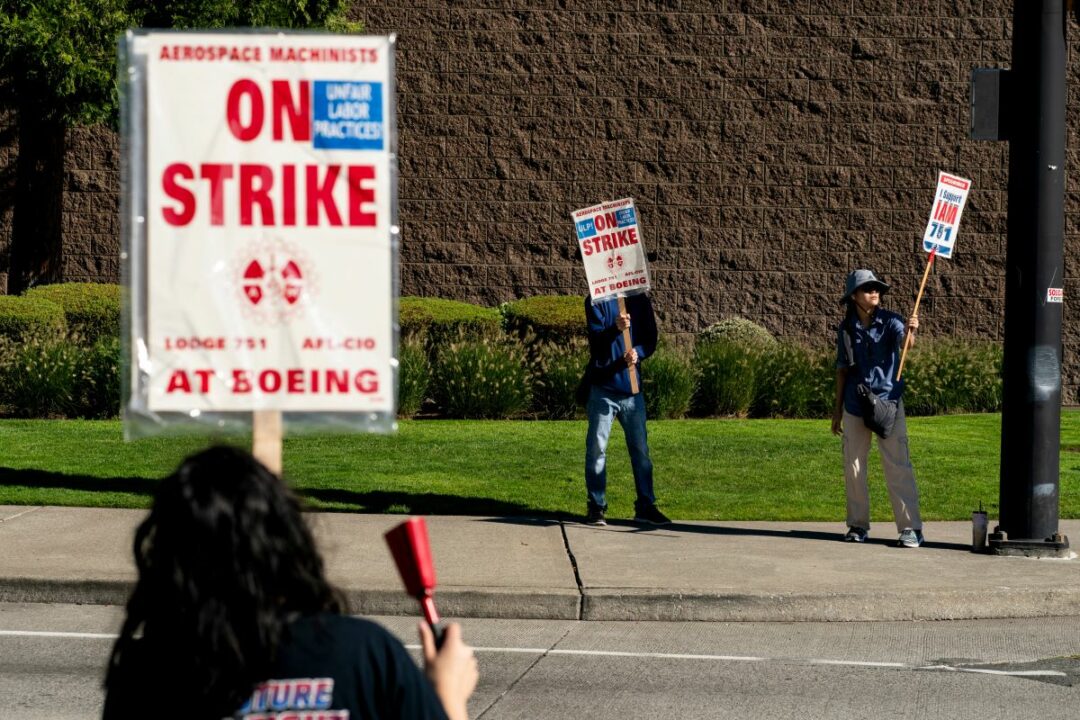
Visit Our Sponsors |
|
|
|
|
|
|
|
|
|
|
|
|
|
|
|
|
|
|
|
|
|
|
|
|
|
|
|
|
|
|
|
|
|
|
|
|
|
|

Workers picket outside the Boeing Co. manufacturing facility on October 3. Photographer: David Ryder/Bloomberg
Boeing Co. workers voted November 4 to accept a new labor contract and end a strike that’s crippled jetliner production for 53 days, clearing a major obstacle for the U.S. planemaker to restore its operations and finances.Some 59% of union members voted in favor of the accord, which includes a 38% wage increase over four years and enhanced retirement contributions, according to the International Association of Machinists and Aerospace Workers district representing some 33,000 striking workers.
“This was a defining moment tonight,” IAM District 751 president Jon Holden said. “This is a victory. We stood strong, we stood tall, we won.” He said more than 26,000 votes had been cast, adding that “I just want to get our members back in the factory.”
Hourly workers can start returning to factories in Washington, Oregon and California as soon as November 6.Boeing’s shares were little changed as of 9:35 a.m. in New York on November 5. The stock has lost about 41% in value this year, putting it on course for its worst annual return since 2008.
The breakthrough represents a victory for new Boeing chief executive officer Kelly Ortberg, clearing the way for him to move forward with plans to rebuild the company’s culture and improve the quality of work in its factories. Ortberg, who has been in the job only three months, inherited a company already reeling from a near-catastrophic accident in January that upended its production, finances and senior management.
The two leaders struck a conciliatory tone after weeks of tense bargaining, threats, standoffs and a peace that was essentially brokered by Acting U.S. Labor Secretary Julie Su.
Ortberg praised the agreement in a message to Boeing employees. “While the past few months have been difficult for all of us, we are all part of the same team,” the CEO said in a statement. “We will only move forward by listening and working together.” U.S. President Joe Biden congratulated both sides for coming together, noting that good contracts are “key to growing the American economy from the middle out and the bottom up.”
Holden also pledged to work with Ortberg.
“He’s new, he’s got a lot to learn,” but the union is “open and available” to helping its members get back up to speed, he said.
Although union negotiators had endorsed the proposal, warning that another rejection risked losing gains secured through weeks of collective bargaining, it had still faced heated opposition — including scattered boos when the vote was announced. Holden acknowledged that the 41% who voted to reject the deal represented a large portion of his membership, and vowed to press for better terms with the next contract talks in 2028. As to whether members should be worried about layoffs now the strike is over, Holden said such a move would be very short-sighted of Boeing. Ortberg instituted a range of cost cuts to weather the fallout from the strike, including a 10% reduction in the workforce alongside hiring freezes and travel restrictions to conserve cash. He took over in August following a shakeup of senior management in the wake of cascading crises that have rocked Boeing since the start of the year.
“There’s 6,000 airplanes or so in the backlog,” Holden said. “They need us to build them and it’s important to get our membership back in the factories.” For many union members, the strike was about far more than pocket-book concerns that dominated headlines. There was a sense of injustice over the low wages locked in by the 2014 contract that cost IAM leaders any leverage for a decade. Then there was widespread anger at a company that has spent handsomely on its senior leaders and looked willing to suffer billions of dollars in losses and economic damages rather than budge on pensions, which Boeing refused to restore.
The strike added to the financial strain on Boeing, costing it about $100 million in lost revenue a day by some estimates. While Boeing averted a likely downgrade of its credit rating to junk status by raising more than $24 billion in capital, it’s not out of the woods yet. The company now faces a long slog as it restarts its factories and nurses suppliers back to health.Jefferies analyst Sheila Kahyaoglu estimates Boeing faces about $1.1 billion in higher salary costs over four years under the deal.
After two months of picket lines and huddling around “burn barrels,” some IAM members voiced relief that the first strike in 16 years was over. They’d lost two months of pay, and faced the squeeze of coming up for their own health insurance. Now they’ll gain an immediate 13% bump and pay and $12,000 signing bonus that makes up for those losses.
“I’m happy,” said Jeremy Cronk, a member of IAM District 751, moments after the vote count was announced. “It’s time to get back to work.”
RELATED CONTENT
RELATED VIDEOS
Timely, incisive articles delivered directly to your inbox.

